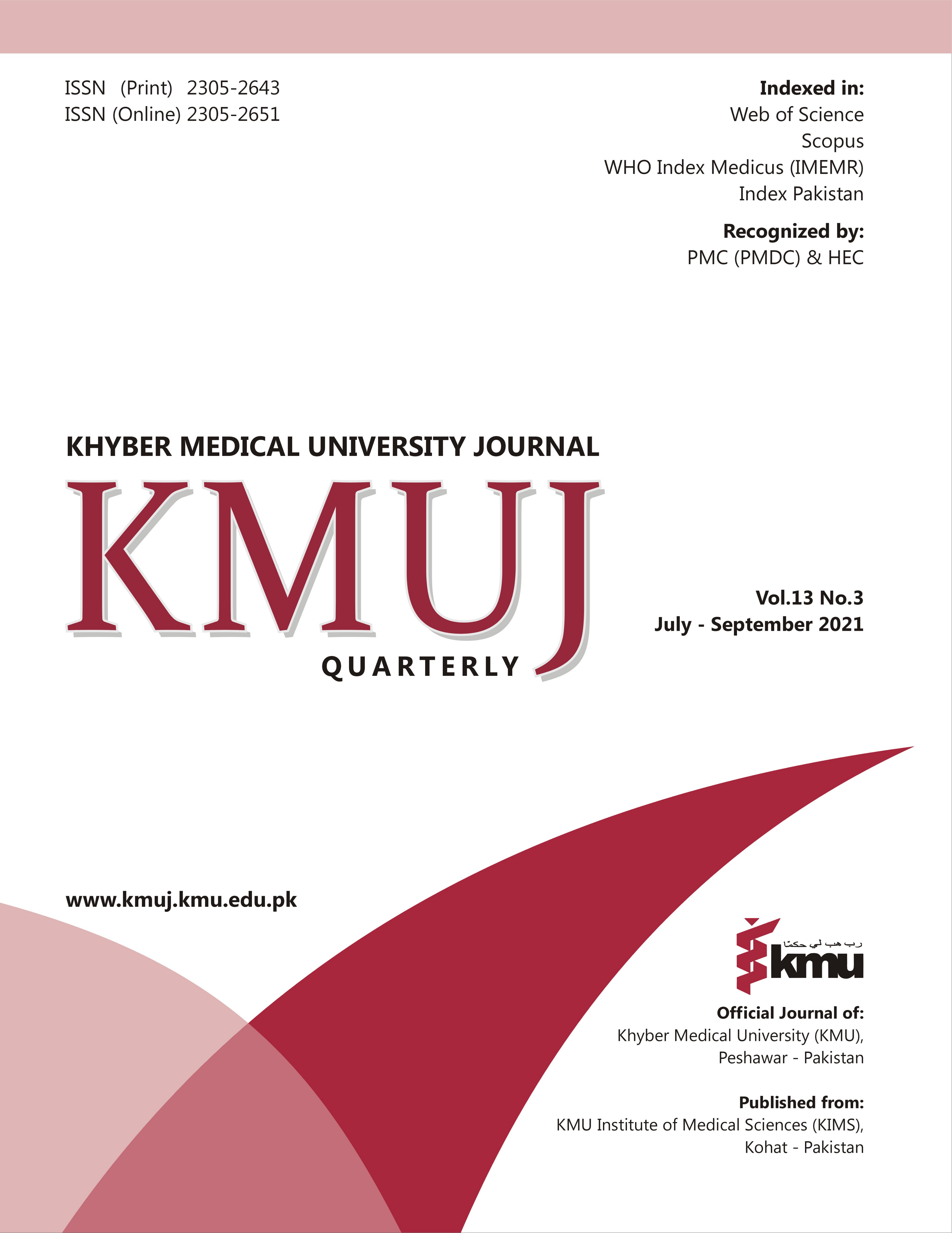COMPARISON OF SARS-COV2 GENOME SEQUENCES FROM PAKISTAN WITH GENOME SEQUENCES FROM OTHER COUNTRIES
Main Article Content
Abstract
OBJECTIVE: To analyze SARS-CoV-2 whole genome reported of Pakistan and compare them with other viral strains collected from other world region to better understand the origin and genetic characterization of the virus.
METHODS: All the available genomic information of SARS-CoV-2 including Pakistani strains were collected from various online sources. Phylogenetic analysis of 131 sequences from 11 countries (Brazil, China, India, Italy, Nepal, Pakistan, Spain, Sweden, Taiwan, USA and Viet-Nam) were performed and compared with other related coronaviruses to find the evolution of virus and its origin. Individual SARS-CoV-2 gene, spike (S) glycoprotein and the receptor binding domain (RBD) with closely related coronaviruses were compared to further explore genetic variations and the likely RBD properties of the virus.
RESULTS: The analysis shows that genome of all analyzed 131 SARS-CoV-2 strains collected from different geographical area were extremely similar, exhibiting >99% sequence identity. Notably, genome of the SARS-CoV-2 has high similarity (89.1% sequence identity) with the two bat-derived severe acute respiratory syndrome (SARS) like betacoronaviruses, bat-SL-CoVZC45 and bat-SL-CoVZXC21 but was sufficiently divergent from SARS-CoV (82.3% similarity) and MERS-CoV (50% similarity). Phylogenetic analysis shows that the SARS-CoV-2 has relatively similar spike glycoprotein with bat-SL-CoVZC45, however, the RBD was more like that of SARS-CoVGZ02.
CONCLUSION: Using different bioinformatics tools, we determined that SARS-CoV-2 has high similarities to bat-derived SARS like betacoronaviruses than SARS-CoV at the whole genome level, however, the RBD was more like that of SARS-CoVGZ02, which shows that they use similar ACE2 as a cell receptor.
Article Details
Work published in KMUJ is licensed under a
Creative Commons Attribution 4.0 License
Authors are permitted and encouraged to post their work online (e.g., in institutional repositories or on their website) prior to and during the submission process, as it can lead to productive exchanges, as well as earlier and greater citation of published work.
(e.g., in institutional repositories or on their website) prior to and during the submission process, as it can lead to productive exchanges, as well as earlier and greater citation of published work.
References
Huang C, Wang Y, Li X, Ren L, Zhao J, Hu Y, et al. Clinical features of patients infected with 2019 novel coronavirus in Wuhan, China. Lancet 2020;395(10223):497-506. https://doi.org/10.1016/S0140-6736(20)30183-5
Peiris JS, Guan Y, Yuen KY. Severe acute respiratory syndrome. Nat Med 2004;10(12 Suppl):S88-97. https://doi.org/10.1038/nm1143.
Zaki AM, van Boheemen S, Bestebroer TM, Osterhaus AD, Fouchier RA. Isolation of a novel coronavirus from a man with pneumonia in Saudi Arabia. N Engl J Med 2012;367(19):1814-20. https://doi.org/10.1056/NEJMoa1211721.
Hajjar SA, Memish ZA, McIntosh K. Middle East Respiratory Syndrome Coronavirus (MERS-CoV): a perpetual challenge. Ann Saudi Med 2013;33(5):427-36. https://doi.org/10.5144/0256-4947.2013.427.
Tang Q, Song Y, Shi M, Cheng Y, Zhang W, Xia XQ. Inferring the hosts of coronavirus using dual statistical models based on nucleotide composition. Sci Rep 2015;5:17155. https://doi.org/10.1038/srep17155.
Fehr AR, Perlman S. Coronaviruses: an overview of their replication and pathogenesis. Methods Mol Biol 2015;1282:1-23. https://doi.org/10.1007/978-1-4939-2438-7_1.
Su S, Wong G, Shi W, Liu J, Lai ACK, Zhou J, et al. Epidemiology, Genetic Recombination, and Pathogenesis of Coronaviruses. Trends Microbiol 2016;24(6):490-502. https://doi.org/10.1016/j.tim.2016.03.003.
Marra MA, Jones SJ, Astell CR, Holt RA, Brooks-Wilson A, Butterfield YS, et al. The Genome sequence of the SARS-associated coronavirus. Science 2003;300(5624):1399-404. https://doi.org/10.1126/science.1085953.
Ruan YJ, Wei CL, Ee AL, Vega VB, Thoreau H, Su ST, et al. Comparative full-length genome sequence analysis of 14 SARS coronavirus isolates and common mutations associated with putative origins of infection. Lancet 2003;361(9371):1779-85. https://doi.org/10.1016/s0140-6736(03)13414-9.
Fung TS, Liu DX. Human Coronavirus: Host-Pathogen Interaction. Annu Rev Microbiol 2019;73:529-57. https://doi.org/10.1146/annurev-micro-020518-115759.
Yu F, Du L, Ojcius DM, Pan C, Jiang S. Measures for diagnosing and treating infections by a novel coronavirus responsible for a pneumonia outbreak originating in Wuhan, China. Microbes Infect 2020;22(2):74-9. https://doi.org/10.1016/j.micinf.2020.01.003.
Kumar S, Stecher G, Li M, Knyaz C, Tamura K. MEGA X: Molecular Evolutionary Genetics Analysis across Computing Platforms. Mol Biol Evol 2018;35(6):1547-9. https://doi.org/10.1093/molbev/msy096.
Saitou N, Nei M. The neighbor-joining method: a new method for reconstructing phylogenetic trees. Mol Biol Evol. 1987;4(4):406-25. https://doi.org/10.1093/oxfordjournals.molbev.a040454.
Felsenstein J. Confidence limits on phylogenies: an approach using the bootstrap. Evolution 1985;39(4):783-91. https://doi.org/10.1111/j.1558-5646.1985.tb00420.x.
Tamura K, Nei M, Kumar S. Prospects for inferring very large phylogenies by using the neighbor-joining method. Proc Natl Acad Sci USA 2004;101(30):11030-5. https://doi.org/10.1073/pnas.0404206101.
Li F, Li W, Farzan M, Harrison SC. Structure of SARS coronavirus spike receptor-binding domain complexed with receptor. Science 2005;309(5742):1864-8. https://doi.org/10.1126/science.1116480.
Lu G, Hu Y, Wang Q, Qi J, Gao F, Li Y, et al. Molecular basis of binding between novel human coronavirus MERS-CoV and its receptor CD26. Nature 2013;500(7461):227-31. https://doi.org/10.1038/nature12328.
Wang N, Shi X, Jiang L, Zhang S, Wang D, Tong P, et al. Structure of MERS-CoV spike receptor-binding domain complexed with human receptor DPP4. Cell Res 2013;23(8):986-93. https://doi.org/10.1038/cr.2013.92.
Wang Q, Qi J, Yuan Y, Xuan Y, Han P, Wan Y, et al. Bat origins of MERS-CoV supported by bat coronavirus HKU4 usage of human receptor CD26. Cell Host Microbe 2014;16(3):328-37. https://doi.org/10.1016/j.chom.2014.08.009.
Hu D, Zhu C, Ai L, He T, Wang Y, Ye F, et al. Genomic characterization and infectivity of a novel SARS-like coronavirus in Chinese bats. Emerg Microbes Infect 2018;7(1):154. https://doi.org/10.1038/s41426-018-0155-5.
Han Y, Du J, Su H, Zhang J, Zhu G, Zhang S, et al. Identification of Diverse Bat Alphacoronaviruses and Betacoronaviruses in China Provides New Insights Into the Evolution and Origin of Coronavirus-Related Diseases. Front Microbiol 2019;10:1900. https://doi.org/10.3389/fmicb.2019.01900.
Guan Y, Zheng BJ, He YQ, Liu XL, Zhuang ZX, Cheung CL, et al. Isolation and characterization of viruses related to the SARS coronavirus from animals in southern China. Science 2003;302(5643):276-8. https://doi.org/10.1126/science.1087139.
Alagaili AN, Briese T, Mishra N, Kapoor V, Sameroff SC, Burbelo PD, et al. Middle East respiratory syndrome coronavirus infection in dromedary camels in Saudi Arabia. mBio 2014;5(2):e00884-14. https://doi.org/10.1128/mBio.00884-14.
Zhou P, Yang X-L, Wang X-G, Hu B, Zhang L, Zhang W, et al. Discovery of a novel coronavirus associated with the recent pneumonia outbreak in humans and its potential bat origin. bioRxiv 2020:2020.01.22.914952. https://doi.org/10.1101/2020.01.22.914952.
